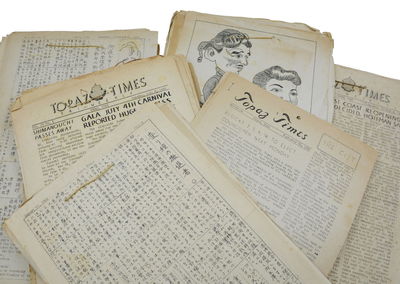Carousel content with 1 slides.
A carousel is a rotating set of images, rotation stops on keyboard focus on carousel tab controls or hovering the mouse pointer over images. Use the tabs or the previous and next buttons to change the displayed slide.
-
 Slide 1:
Slide 1:
-
 Slide 2: no title
Slide 2: no title -
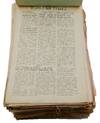 Slide 3: no title
Slide 3: no title -
 Slide 4: no title
Slide 4: no title -
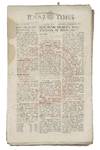 Slide 5: no title
Slide 5: no title -
 Slide 6: no title
Slide 6: no title -
 Slide 7: no title
Slide 7: no title -
 Slide 8: no title
Slide 8: no title -
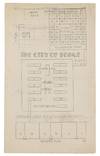 Slide 9: no title
Slide 9: no title -
 Slide 10: no title
Slide 10: no title -
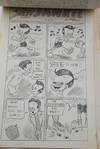 Slide 11: no title
Slide 11: no title -
 Slide 12: no title
Slide 12: no title -
 Slide 13: no title
Slide 13: no title -
 Slide 14: no title
Slide 14: no title -
 Slide 15: no title
Slide 15: no title -
 Slide 16: no title
Slide 16: no title -
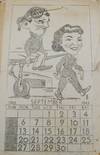 Slide 17: no title
Slide 17: no title -
 Slide 18: no title
Slide 18: no title
first edition
1945 · Topaz, UT
by Katayama, Taro [Managing Editor]; Iwao Kawakami [Weekly Editor]
Topaz, UT: The Topaz Times, 1945. Four hundred issues of The Topaz Times; 197 of which are in English and 203 in Japanese; with 47 fragments of various issues, 17 illustrated calendars, and nine pieces of ephemera including high school newspapers from Topaz War Relocation Center, Ram-bler and Topazette. Following two Pre-Issues from September of 1942, the run spans from Vol. II #49 (February 27, 1943) to Vol. X #19 (March 6, 1945). The newspaper was issued with varying frequency, from daily to weekly or less. Illustrated with drawings, many of which are cartoons. Each issue from 2 to 10 pages or so, generally printed on both sides of mimeographed sheets (truncated) measuring about 36.5 x 22.5 cm (14¼" x 8 ¾"). Stitched together into monthly groups, or fascicles, with string through small holes in the top margins. Very Good overall with some edge wear, chips, and tears; very infrequent loss of text or biopredation. Most issues appear complete but archive is sold “as is” with regards to completeness. Rare.
The English language issues are as follows: vol. II, no. 49; vol. III, nos. 6, 7, 8-B, 9, 13, 15, 18-25, 27, 30, 31, 33, 34, 36, 38, 39, 40 (two copies); vol. IV, nos. 2, 5, 7, 8-A, 9, 11-17, 20, 21, 23, 24 (two copies), 26, 27, 29-31, 34-36; vol. V, nos. 1, 3-13, 16-25, 27-31, 33 (two copies), 34, 36 (two copies);
vol. VI nos. 1 (two copies), 2, 3 (two copies), [3]-8, 9 (two copies), 10-34; vol. VII nos. 1-3, 5-7, 8 (two copies), 9, 10, 12-22, 24, 25, 27 (two copies); vol. VIII, nos. 1-3, 4 (two copies), 7, 9 (two copies), 10, 12-15, 19, 21; vol. IX, nos. 1-7, 9, 10, 13-18, 20, 21, 23-26; vol. X, nos. 1-3, 19.
Japanese issues are as follows: vol. II, no. 49; vol. III nos. 3, 6-8, 8-B, 12-14, 18-22, 23 (two copies), 25, 29-39; vol. IV, nos. 2-4, 7, 8-A, 9, 10, 12-17, 19 (two copies), 20, 21, 23, 24, 26-30, 31 (two copies), 33-37, 39; vol. V nos. 1-29, 30 (two copies), 31, 33 (two copies), 34, 36 (two copies); vol. VI, nos. 1-35; vol. VII, nos. 1-3, 5, 6 (two copies), 7, 8 (two copies), 9, 10, 12-17, 19-22, 24, 25, 27 (two copies); vol. VIII, nos. 1-3, 4 (two copies), 6, 7, 9, 11-15, 18, 19 (two copies), 20, 22, 25; vol. IX, nos. 1-11, 13-19, 21, 23-26; vol. X, nos. 1, 3.
Special editions include: Election Special, June 14, 1943, bilingual; Extra, Dec 18, 1944; Extra / Special Edition, Jan. 31, 1944, lists youths named in draft; Pre-Issue, Sept. 26, 1942. 6 pp.; Pre-Issue, No. 3, September 30, 1942. 6 pp.; Special edition, Dec. 18, 1943, 2 pp.; Special edition, January 21, 1944, bilingual; Special edition, May 19, 1944, bilingual; Special edition, May 23, 1944, bilingual (two copies; “The Sporting Green” January 22, 1944, 1 pp.; Topaz Times Extra, (Two Issues) April 16, 1943 & April 20, 1943, bilingual.
Illustrated monthly calendars: May 1943, August-December 1943; Happy New Year 1944 (two copies), January 1944 (two copies), February 1944, March 1944, May-August 1944, Dec. 1944.
Incomplete issues: Sept. 18, 1943 English pp. 3 & 4; Japanese, Americanization Supplement only; Sept. 23, 1943 English, pp. 2, 3; vol. IV #37 English, pp. 1-3, 5; Sept. 25, 1943, Japanese, Americanization Supplement; vol. IV #38, Japanese, p. 3; vol. IV, #16, English, duplicate of pages 1 & 2; August 12, 1943, English p. 5, Japanese p. 3; vol. IV, #19 English, pp. 1, 2, 5, 6; vol. IV, #22 English pp. 1, 2, 5-8; Japanese pp. 3,4; vol. IV, #27, English pp. 7,8; vol. V #1 Japanese, pp. 2,3; vol. V, #2 English p. 3; vol. V #12 Japanese p. 3; vol. IX #11, English, pp. 3, 4; vol. VIII #25, English, p. 3, 4; vol. VIII #21, Japanese, pp. 3, 4 only but may just be misnumbered; vol. #20, English, p. 5; Jan. 6, 1944, Japanese pp. 3,4; Jan. 8, 1944, Japanese pp. 3,4; Feb. 19, 1944 English p. 5 b/w Japanese p. 3; vol. VII #6, English, pp. 5, 6; vol. V, #36 Japanese p. 3; Dec. 16, 1943 English p. 3, Japanese p. 3; Dec. 9, 1943 English p. 3; Japanese p. 3 (two copies); Dec. 24, 1963, pp. 3, 4, 7, 8; vol. V #28 Japanese pp. 1,2; Dec. 18, 1943 English, pp. 3, 4; Dec. 11, 1943, English pp. 3, 4; Dec. 21, 1943 English, p. 3
Aug. 9, Japanese pp. 3,4; vol. VI #1 Japanese pp. 3-6; vol. VII #18 Japanese pp. 3, 4; June 17, 1943, Japanese, pp. 4, 5; vol. III, #37 English p. 3; vol. III #35, English, p. 3; June 10, 1943, Japanese p. 3, English pp. 3-5; vol. IV #4, English pp. 3, 4; July 15, 1943, English p. 3, Japanese p. 3; April 24, 1943, English pp. 3-6; April 22, 1943, English p. 5, Japanese p. 3; vol. III #8, English pp. 3-5; vol. III #21, Japanese pp. 1, 2 (two copies); vol. III #26, English pp. 3-5, Japanese p. 3; Sept. 25, 1943, Americanization Supplement; August 14, 1943, English, pp. 3, 4; Sept. 25, 1943, English, p. 5; vol. X, #2, Japanese, pp. 1, 2, 5.
An immense archive of original issues of the camp newspaper for the Topaz War Relocation Center, which opened near the town of Delta, Utah in September 1942 and closed in October 1945. Now considered concentration camps, the centers, several of which were scattered across the American west, housed Americans of Japanese descent and immigrants who had come to the United States from Japan. President Franklin Roosevelt signed controversial Executive Order 9066 in February 1942, ordering people of Japanese ancestry to be incarcerated in what were euphemistically called "relocation centers" during World War II. Most of the people incarcerated at Topaz came from the Tanforan Assembly Center in California, and had previously lived in the San Francisco Bay Area. The articles in these newspapers are concerned mainly with internal camp matters, with much on schools and intramural sporting events, churches and religious activities, camp safety, navigating the camp bureaucracy, births and a few deaths, Nisei soldiers who were either drafted or enlisted into service, job opportunities both inside and outside the camp (some of which were at The Topaz Times itself), and much more. The tone is surprisingly positive and upbeat, though perhaps that can be expected due to overt or implied censorship. The illustrations in particular (which occasionally take the form of full page comic strips with reoccuring characters) demonstrate a unique artistic sensibility born of the grim realities of internment that could not be directly challenged, tempered with a distinctly American mid-century optimism. These newspapers' most unsettling quality is their continual insistence on finding and displaying normalcy in the midst of a monumental abnormality, namely the tremendous injustice of mass incarceration and displacement on the basis of ethnicity. (Inventory #: 140943882)
The English language issues are as follows: vol. II, no. 49; vol. III, nos. 6, 7, 8-B, 9, 13, 15, 18-25, 27, 30, 31, 33, 34, 36, 38, 39, 40 (two copies); vol. IV, nos. 2, 5, 7, 8-A, 9, 11-17, 20, 21, 23, 24 (two copies), 26, 27, 29-31, 34-36; vol. V, nos. 1, 3-13, 16-25, 27-31, 33 (two copies), 34, 36 (two copies);
vol. VI nos. 1 (two copies), 2, 3 (two copies), [3]-8, 9 (two copies), 10-34; vol. VII nos. 1-3, 5-7, 8 (two copies), 9, 10, 12-22, 24, 25, 27 (two copies); vol. VIII, nos. 1-3, 4 (two copies), 7, 9 (two copies), 10, 12-15, 19, 21; vol. IX, nos. 1-7, 9, 10, 13-18, 20, 21, 23-26; vol. X, nos. 1-3, 19.
Japanese issues are as follows: vol. II, no. 49; vol. III nos. 3, 6-8, 8-B, 12-14, 18-22, 23 (two copies), 25, 29-39; vol. IV, nos. 2-4, 7, 8-A, 9, 10, 12-17, 19 (two copies), 20, 21, 23, 24, 26-30, 31 (two copies), 33-37, 39; vol. V nos. 1-29, 30 (two copies), 31, 33 (two copies), 34, 36 (two copies); vol. VI, nos. 1-35; vol. VII, nos. 1-3, 5, 6 (two copies), 7, 8 (two copies), 9, 10, 12-17, 19-22, 24, 25, 27 (two copies); vol. VIII, nos. 1-3, 4 (two copies), 6, 7, 9, 11-15, 18, 19 (two copies), 20, 22, 25; vol. IX, nos. 1-11, 13-19, 21, 23-26; vol. X, nos. 1, 3.
Special editions include: Election Special, June 14, 1943, bilingual; Extra, Dec 18, 1944; Extra / Special Edition, Jan. 31, 1944, lists youths named in draft; Pre-Issue, Sept. 26, 1942. 6 pp.; Pre-Issue, No. 3, September 30, 1942. 6 pp.; Special edition, Dec. 18, 1943, 2 pp.; Special edition, January 21, 1944, bilingual; Special edition, May 19, 1944, bilingual; Special edition, May 23, 1944, bilingual (two copies; “The Sporting Green” January 22, 1944, 1 pp.; Topaz Times Extra, (Two Issues) April 16, 1943 & April 20, 1943, bilingual.
Illustrated monthly calendars: May 1943, August-December 1943; Happy New Year 1944 (two copies), January 1944 (two copies), February 1944, March 1944, May-August 1944, Dec. 1944.
Incomplete issues: Sept. 18, 1943 English pp. 3 & 4; Japanese, Americanization Supplement only; Sept. 23, 1943 English, pp. 2, 3; vol. IV #37 English, pp. 1-3, 5; Sept. 25, 1943, Japanese, Americanization Supplement; vol. IV #38, Japanese, p. 3; vol. IV, #16, English, duplicate of pages 1 & 2; August 12, 1943, English p. 5, Japanese p. 3; vol. IV, #19 English, pp. 1, 2, 5, 6; vol. IV, #22 English pp. 1, 2, 5-8; Japanese pp. 3,4; vol. IV, #27, English pp. 7,8; vol. V #1 Japanese, pp. 2,3; vol. V, #2 English p. 3; vol. V #12 Japanese p. 3; vol. IX #11, English, pp. 3, 4; vol. VIII #25, English, p. 3, 4; vol. VIII #21, Japanese, pp. 3, 4 only but may just be misnumbered; vol. #20, English, p. 5; Jan. 6, 1944, Japanese pp. 3,4; Jan. 8, 1944, Japanese pp. 3,4; Feb. 19, 1944 English p. 5 b/w Japanese p. 3; vol. VII #6, English, pp. 5, 6; vol. V, #36 Japanese p. 3; Dec. 16, 1943 English p. 3, Japanese p. 3; Dec. 9, 1943 English p. 3; Japanese p. 3 (two copies); Dec. 24, 1963, pp. 3, 4, 7, 8; vol. V #28 Japanese pp. 1,2; Dec. 18, 1943 English, pp. 3, 4; Dec. 11, 1943, English pp. 3, 4; Dec. 21, 1943 English, p. 3
Aug. 9, Japanese pp. 3,4; vol. VI #1 Japanese pp. 3-6; vol. VII #18 Japanese pp. 3, 4; June 17, 1943, Japanese, pp. 4, 5; vol. III, #37 English p. 3; vol. III #35, English, p. 3; June 10, 1943, Japanese p. 3, English pp. 3-5; vol. IV #4, English pp. 3, 4; July 15, 1943, English p. 3, Japanese p. 3; April 24, 1943, English pp. 3-6; April 22, 1943, English p. 5, Japanese p. 3; vol. III #8, English pp. 3-5; vol. III #21, Japanese pp. 1, 2 (two copies); vol. III #26, English pp. 3-5, Japanese p. 3; Sept. 25, 1943, Americanization Supplement; August 14, 1943, English, pp. 3, 4; Sept. 25, 1943, English, p. 5; vol. X, #2, Japanese, pp. 1, 2, 5.
An immense archive of original issues of the camp newspaper for the Topaz War Relocation Center, which opened near the town of Delta, Utah in September 1942 and closed in October 1945. Now considered concentration camps, the centers, several of which were scattered across the American west, housed Americans of Japanese descent and immigrants who had come to the United States from Japan. President Franklin Roosevelt signed controversial Executive Order 9066 in February 1942, ordering people of Japanese ancestry to be incarcerated in what were euphemistically called "relocation centers" during World War II. Most of the people incarcerated at Topaz came from the Tanforan Assembly Center in California, and had previously lived in the San Francisco Bay Area. The articles in these newspapers are concerned mainly with internal camp matters, with much on schools and intramural sporting events, churches and religious activities, camp safety, navigating the camp bureaucracy, births and a few deaths, Nisei soldiers who were either drafted or enlisted into service, job opportunities both inside and outside the camp (some of which were at The Topaz Times itself), and much more. The tone is surprisingly positive and upbeat, though perhaps that can be expected due to overt or implied censorship. The illustrations in particular (which occasionally take the form of full page comic strips with reoccuring characters) demonstrate a unique artistic sensibility born of the grim realities of internment that could not be directly challenged, tempered with a distinctly American mid-century optimism. These newspapers' most unsettling quality is their continual insistence on finding and displaying normalcy in the midst of a monumental abnormality, namely the tremendous injustice of mass incarceration and displacement on the basis of ethnicity. (Inventory #: 140943882)
